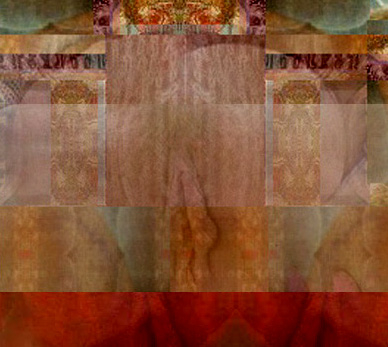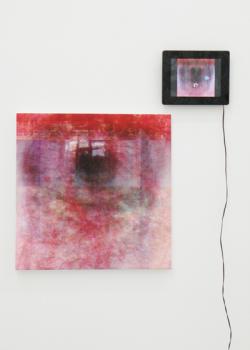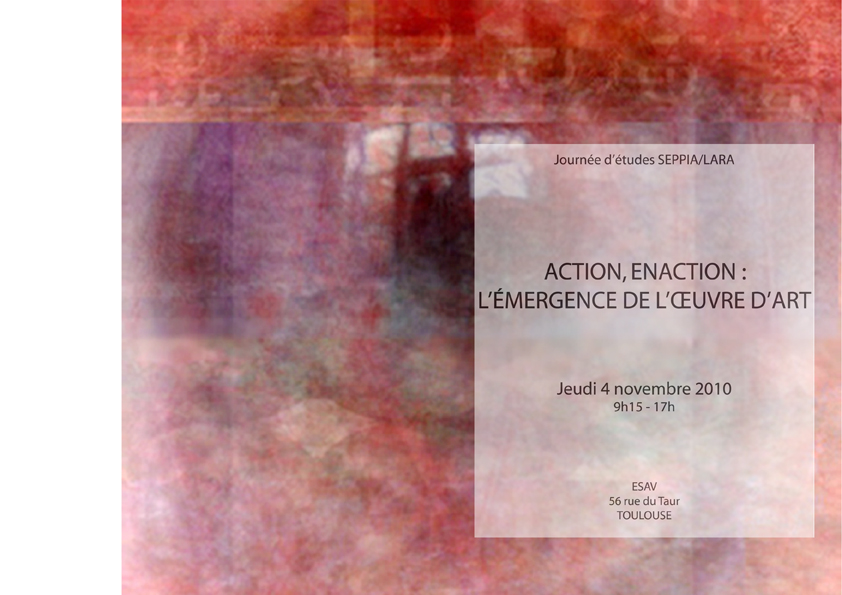
Emergence of the New Paradigm: Viractuality
by Joseph Nechvatal
talk/demo delivered at the École Supérieure d'AudioVisuel
Université de Toulouse le Mirail
November 3rd, 2010 in Toulouse, France

the birth Of the viractual
Joseph Nechvatal
2001
70 x 70 inches
computer-robotic assisted acrylic on canvas
This paper will investigate the idea of the emergence of the viractual era, which I maintain is already upon us. First, I will formulate an argument for what the viractual is and what viractualism is about.
As I work on this idea in my own work, I will illustrate my argument with examples from my own art practice, but by no means is the concept of viractualism limited to my art activity alone. On the contrary, it is a widely used – perhaps dominant - technique, even if it has not yet been fully recognized as being so, yet.
First, what it is.
Viractuality is a theory that strives to see, understand, and create interfaces between the technological and the biological. The basis of the viractual conception is that virtual producing computer technology has become a noteworthy means for making and understanding contemporary life (and thus art). And that this virtual production – a digital production that has been going on for a long time now - brings artists to a place of paradox where one finds increasingly the emerging of the computed (the virtual) with the uncomputed corporeal (the actual). This fusion motif - which tends to contradict some central techno clichés of our time - is what I call the viractual. It is the poetic welding of fusion/paradox that accounts for much of the potency and transportative agency of the theory - and the art that it produces.
A key influence in the formation of my theory of viractuality was Gilles Deleuze's consideration of Spinoza - the 17th century philosopher who merged mind and matter into one material. Moreover, it is a concept close to that of augmented reality, which is the use of transparent displays worn as see-through glasses on which computer data is projected and layered.
Digitization is a key metaphor for viractuality in the sense that it is the elementary translating procedure today. But the viractual recognizes and uses the power of digitization while being culturally aware of the glamourous values of monumentality and permanency - qualities that can be found in some previous compelling analog art that grounded itself in the spiritual value of beauty.
For me, viractualism signals a new emerging sensibility respecting the integration of certain aspects of science, technology, myth and consciousness – an aesthetic consciousness struggling to attend to the prevailing contemporary spirit of our age in which everything, everywhere, all at once is connected in a rhizomatic web of transmission. But the lurking viractual realm is also a political-spiritual chaosmos in the sense that new forms of order may emerge in such a way that any form of order is only temporary and provisional. Within viractual creation and understanding, all signs are subject to boundlessly inverted semiosis - which is to say that they are translatable into other signs. Here, of course, it is possible to find resonances and affinities between formal and conceptual opposites. Hence, I wish to suggest that the term and concept viractual (and viractualism or viractuality) maybe helpful in defining our now third-fused inter-spatiality reality – a reality forged from the meeting of the virtual and the actual.
Now, what it means.
The history of art and the history of technology are often marked by ruptures. Most histories overlook moments where deep fusion occurs, as I see happening now with viractuality. Perhaps another temporal model for cultural consciousness is needed. Something other than the majestic forward and upward thrusting model of evolution. Something more humbly folded in on itself (as Deleuze suggests). Or perhaps something even more insinuatingly penetrating – as in a viral-host model. I have chosen the viral model – so let us now consider the activities of the viractual as a surge of emergent and embedded critical consciousness that offers us a formal clarity true to our glorious age.
After a long period of temporal disjunctions following the demise of the modernist project and the excessive abuses of the post-modernist non-project; I wish to now suggest that a new clarifying paradigm has emerged based not, however, on the ideals of the raw, the pure or the reduced - but rather on the internal tic-tic-tic bomb time of the embedded and patient viral attack. So I am suggesting here a seething project of critique within critique that re-energizes the broken gaps of temporal displacement that followed the demise of modernism and the appearance of now listless – super fragmented – irresponsible – glut of post-modern de-construction.
When looking at cultural production through the paradigm of the viral viractual, many former binary oppositions fail to function in a stable way - and start to pulse – transfusing consciousness. Most basically, even the definitions of life and death are destroyed by this model; as a biological virus is precisely neither alive nor not-alive – as it depends for its existence totally on it's host's viability. The seeing-power of the host/parasite model alone must not escape us.* A virus cannot – and does not – exist alone. It exists solely by entering in and coupling. So when we add the once binary definitions of virtual and actual into the voluptuous viral model of existence - and observe how they interact - a form of both/and fusion difference appears dominant within the scope of the viractual lens.
What I find exciting about this viral viractuality is the tendency here to discover and produce stuttering, nervous discrepancies between art's internal theoretical and external manufacturing mechanisms. For example, the instantaneous reading of reduced modernist form – also typical of pop art form – is problematized by buried (often cryptic) fugitive qualities of omnijective** informational de-materiality. Unsustainable forms of opposition that are exploded by the viral viractual time bomb are: the mind-body dualism typical of the western philosophical tradition, thus the once held opposition between the physical and the conceptual, reality and representation, nature and culture, presence and potentiality, and the (most central to my artistic production) still and the moving. A clear enthusiasm for post-humanist metamorphosis is evident here, where the interchange between one body and another dominates.
Other now exploded ruptures include: the classical and romantic, repose and energy, carnality and spirituality, organization and vigor, simplicity and complexity, smooth and rough, clarity and chaos, restraint and effusion, sparseness and abundance, abstraction and specificity, stability and stress, composure and imbalance, plan and chance.
So viral-viractality means cultivating another form of grandeur more concerned with inter-related passage than avant-garde rupture. Its leitmotiv is an interest in seductive infiltrations. Yet I believe it still can be said that viral-viractality is revolutionary in that it surfs the wake of the digital revolution while, in my case, participating in the aesthetics of glitch and the art of noise. But it is revolutionary in a new non-ruptured sense (what a dreaded sense of stress waiting for a rupture that may or may never come) as it uses an inner-outer confusion (or double sense writ grand) that is not clearly obvious on first-take by design. Yet it is non-all inclusive, as its strategy clearly has no interest in art that is without compelling poetic narrative, mechanical, designy, decorative or ornamental. Rather, it is interested in fabricating unique artificial objects and experiences of sensitivity via conflation. Here I offer, as example, my conflation of the painterly glazing tradition with genetic programming, where a very intense analog-digital difference is confronted and addressed in both directions.
For anyone unfamiliar with genetic programming, briefly, it is a technique for writing code in a computer program based on artificial intelligence that uses an algorithm-based method that takes its programming cues from biology. In my case, from the biology of the virus. Indeed, for me, bio-tech genetic programming as applied to the traditions of painting and art music is so important to the ideas of viractuality that it may be said to be emblematic of it. This because it represents the seminal function of viractuality: that activity that occurs between the wild real-time and the captured archived.
Again, my interest is not in denying differences here between the two modes, but in investigating how these two models may interact in new ways as we pay attention to the direction of light as it applies to display. Cyborgian computer-assisted forms of culture and social activity (keep in mind that around 75% of stock trades are now made automatically by computers using algorithms) raises important issues of scale, materiality, and intention. But in viractuality, energetic connections within competing forms and forces are relished. Thus the penetrating viractual lends us a sense of new beginnings, albeit absent the rush of radical rupture. It is an idea of viral temporal interruption alined with the haunting quality of the phantasmagorical – and that is what lends it its sense of authenticity in our age of de-materialized informational codes.

scOpOphilia
Joseph Nechvatal
2009
20 x 20 inches, 50 x 50 cm
computer-robotic assisted acrylic on canvas and screen with digital viral attack animation
* What is the definition of parasite-host? …....... art dealer
**The omnijective concept arose out of the discoveries of quantum physics, a non-spatial physics (and logic) which has been shown to parallel the workings of consciousness itself. (Clarke, C. J. S. 1995. "The Nonlocality of Mind" In Journal of Consciousness Studies: Controversies in Science and the Humanities, Vol. 2, No. 3, pp. 231-240) More specifically, the concept of omnijectivity emerged from the theories of quantum physicist David Bohm (1917-1992), protégé of Albert Einstein; and Karl Pribram, author of the neuropsychological textbook Languages of the Brain. Pribram noted how modern theories of how the brain stores memories did not explain how memories seem to be distributed throughout the brain as a whole. Each memory a person has was believed to have a specific location somewhere in the brain cells. Pribram, however, made the discovery that memories are not localized, but rather they are somehow spread out or distributed throughout the brain as a whole. Even when much damage is done to a brain, or pieces of it are removed, organisms don't lose sections of their memory. He knew of no process that could account for such a phenomenon. Finally, the process that made the most sense in metaphorically explaining this aspect of the brain was holography.
But Pribram was not alone in adapting the holographic model in explaining reality. David Bohm also arrived at the conclusion that the universe operates under holographic principles. Bohm, who had studied at the University of California, Berkeley with Julius Robert Oppenheimer (1904-1967) (noted theoretical physicist and director of the Los Alamos Laboratory during the 1943 to 1945 development of the atomic bomb), received his Ph.D. in Physics in 1943 and taught widely before becoming professor emeritus of theoretical physics at London University. His explorations into the nature of consciousness were stimulated by Jiddu Krishnamurti (1895-1986) and later by the Dalai Lama. His most celebrated book is Wholeness and the Implicate Order in which he expresses his disinclination with the previous prevailing interpretations of quantum theory and suggests that an unseen order is at work beneath the ostensible chaos and lack of continuity of the individual particles of matter.
Bohm had been dissatisfied with the unexplained dual nature of subatomic particles, the fact that they behave sometimes as particles and sometimes as waves. According to Bohm, the holographic model explains it. Hence, Bohm claimed that though our plane of reality makes it seem as if things are separated, at a deeper level of reality everything in the universe is part of a total unified continuum (thus subject and object coalesce in omnijectivity). Holographic film is an appropriate model, according to Bohm, because of its implicate order, as the image is encoded in the film's interference patterns. It contains a hidden perceptual totality enfolded throughout the whole. Equivalents to this recognition exist in fractals in the sense that they present a system in which all parts are encode into the structure of the whole; that a small extract contains, or has enfolded within it, the essential features of the whole. The hologram projected from the film is an explicate order because it represents the unfolded and perceptible version of the image. This relational structure means a mutual and dynamic coexistence where each part depends in its being on the other part. This relational structure theorizes a space/time matrix (the enfolded order) which in itself has no mass or density but is the source of all that we call matter. This implicate order acts like a projector of the explicate order in a way which can be likened to a hologram.
Hence, Bohm sought to develop a theory of reality that would be inclusive and whole; a coherent hyper-spectacle of omnijectivity in which things hook together. As Bohm said in his key book Wholeness and the Implicate Order (a book which defines a seamless physical order of continuous wholeness), "I would say that in my scientific and philosophical work, my main concern has been with understanding the nature of reality in general and of consciousness in particular as a coherent whole, which is never static or complete but which is an unending process of movement and unfoldment". (Bohm, D. 1980. Wholeness and the Implicate Order. London: Ark Paperbacks, p. 9) Also in the book, Bohm emphasized the distinction between wholeness and holism, because he felt some holistic theories have had very negative effects in the past.

